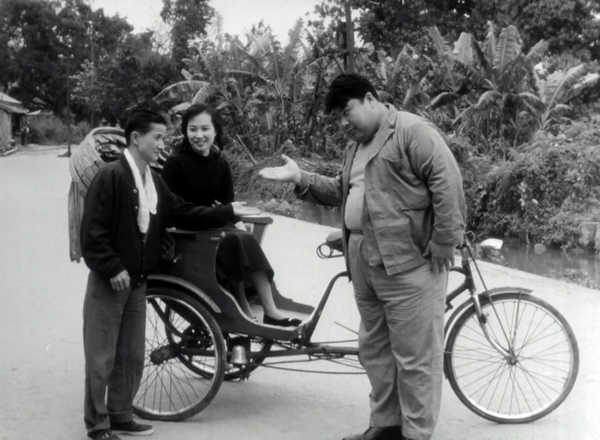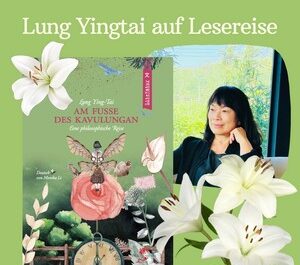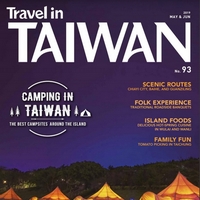Brother Wang and Brother Liu Tour Taiwan
王哥柳哥遊台灣
Tailian Film Company
Executive Producer: Lai Guocai (賴國材)
Producer: Yang Zuguang (楊族光)
Directors: Li Xing (李行),Fang Zhen (方震),Tian Feng (田豐)
Screenplay: Xiao Tong (蕭銅)
Cinematography: Chen Zhongxin (陳忠信)
Lighting: Chen Zhongyi (陳忠義)
Sound: Lin Kunqi (林焜圻)
Music: Zhou Lanping (周藍萍)
Editors: Li Xing (李行),Shen Yekang (沈業康)
Cast: Shorty Cai [Zhang Fucai] (矮仔財, [張福財]), Li Guanzhang (李冠章), Ke Yuxia (柯玉霞)
1959 - Black and White - 155 minutes
Synopsis
Tubby shoeshine man Brother Wang (Li Guanzhang) shares a room with his best friend, rickshaw driver Brother Liu (Shorty Cai). A fortune teller predicts Wang will strike it rich in three days, but Liu will die in 44 days. When Wang wins the lottery three days later, their celebrations turn sour when they remember the other half of the prediction. Wang decides his buddy should have the trip of a lifetime before he dies, and they set off around their beautiful homeland, the island of Taiwan. The naïve working-class men experience a lifestyle of luxury for the first time and fall into many a muddle. Eventually, they return to Taipei, where Liu prepares to spend his final moments with his girlfriend, A-hua (Ke Yuxia).
Commentary
Brother Wang and Brother Liu Tour Taiwan was a ground-breaking film in more ways than one. Much loved by audiences, it is remembered to this day. First, the Laurel and Hardy-style antics of Li Guanzhang and Shorty Cai made the film Taiwanese-language cinema’s first comedy blockbuster. The first Taiwanese-language films were mostly based on local gezaixi operas. The decision to branch out into genre cinema with an original script was risky, but it was a risk that paid off. Second, Brother Wang and Brother Liu also launched at least seven sequels over the next few years. All starred Li Guanzhang and Shorty Cai, who rapidly became household names. Most were made by the same team. In the process Taiwanese-language cinema’s first movie franchise was born.
In addition to comedy, the appeal of the film lay in its display of Taiwan’s scenic beauty, including a trip to Sun Moon Lake in the island’s Central Mountain Range, as well as the sights of coastal cities including Taipei, Beitou, Kaohsiung, Taiwan, Pingtung, and more. Taiwanese audiences were used to feature films coming from elsewhere during the Japanese colonial era (1895-1945) – Shanghai, Tokyo, and Hollywood. The new Chiang Kai-shek government tried to focus attention on China. It encouraged audiences to think of the island as part of China and to speak Mandarin, not Taiwanese. In these circumstances, hearing the local spoken language was a novelty, and part of what attracted audiences to Taiwanese-language films. Seeing their own homeland on screen as the setting of dramatic features further underlined the appeal of the local. Today, the film is a nostalgia trip for older audiences. For younger people, its location-based footage provides rare and precious insights into what everyday life in Taiwan looked like 60 years ago. However, amidst all the laughter, Brother Wang and Brother Liu Tour Taiwan also displays attitudes towards women, Indigenous and LGBTQ Taiwanese that would not be acceptable today but were taken for granted back then.
As Brothers Wang and Liu toured the island, they also accomplished a third “first.” In retrospect, we can see that they launched the huandao (環島) or “round-the-island” phenomenon. “Round-the-island” is both a new distinctly Taiwanese sub-genre of the road movie, and a real-life tourism phenomenon. The most popular recent cinematic example has been the bicycle film, Island Etude (Lianxiqu, 2006). In the road movie genre, the journey is nearly always a road of self-discovery. In the round-the-island film, that journey simultaneously traces the effective border of Taiwan itself, inscribing the discovered self as a Taiwanese self. This is as true for Brothers Wang and Liu and their audiences in the 1950s as it is for the young Taiwanese cycling around the island in what has almost become a coming of age ritual today. Ironically, Island Etude was a rare contemporary Taiwanese whose fame spread beyond the island. As a result, it is no longer only locals but also visitors who cycle round the coastal road as part of their Taiwan trip.
Finally in its catalogue of firsts, Brother Wang and Brother Liu Tour Taiwan was the debut feature of Li Xing (a.k.a. Lee Hsing), the main co-director on the film. He went on to become one the most successful Taiwanese directors of the next two decades, with major hits like Beautiful Duckling (Yangya Renjia, 1964) and Execution in Autumn (Qiu Jue, 1972). However, all of his later films were Mandarin-language features. Li himself was born on the mainland in 1930 and only moved to Taiwan with the Kuomintang retreat to the island from China in 1948. His role in Brother Wang and Brother Liu Tour Taiwan not only helps to account for its confident direction, but also challenges the common assumption that Taiwanese-language and Mandarin-language cinema formed two separate worlds. In practice, talent moved across both industries, facilities were sometimes shared, and hit films in either language were dubbed into the other language to maximize box office.
Free entrance.
Booking via website required.
Text source and photocredit: https://taiyupian.uk/




